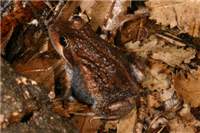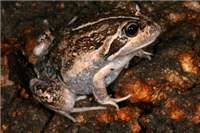Family
Myobatrachidae
Genus
Lymnodynastes
Species
dumerilii
Threats/Control Methods - Regional
Broadscale threats such as habitat change, salinisation, degraded water quality, human impact through processes such as urbanisation. Despite L. dumerilii not currently being considered at risk, care should be taken at all times when entering frog habitats due to the risk of spreading disease, including the Chytrid fungus (chytridiomycosis). To prevent the spread of the Chytrid fungus it is important to wash your shoes before entering and after leaving frog habitats. For more information on the Chytrid fungus © Link to fact sheet http://www.deh.gov.au/biodiversity/invasive/publications/c-disease/
Local/Urban Actions
You can encourage frogs into your own backyard by including habitat features in your garden. The Ginninderra Catchment Group, Australian National University and Environment ACT have developed a guideline to help you encourage frogs into your backyard called Creating a Frog Friendly Habitat in the ACT Community.
Making Frog friendly gardens provides frogs such as L.dumerilii with new habitats, helping to replace those lost through urbanisation.You can also get involved in monitoring local frog populations. Frogwatch is an annual program run to monitor the presence and abundance of frogs within the ACT region. The Frogwatch program provides training for community volunteers each October, with monitoring then being undertaken by volunteers over a two week period.
For more information on Frogwatch contact:The ACT Frogwatch Coordinator, Ginninderra Catchment Group; Ph (02) 6278 3309 or email: [email protected]
Distinguishing Features
In general this species is grey-brown in colour; has a distinctive thick black band from the ear to the eye and a pale stripe from the eye to above the arm; the belly may be white to a mottled grey. The tadpoles of this species are large, up to 9cm long in the sub-species insularis. In general the tadpoles are dark brown to black in colour. Distinguishable from most other frog species in the ACT by their greater size, growing to as large as 8.5 cm.
Common name/s
Banjo Frog, Eastern Banjo Frog, Pobblebonk, Eastern Pobblebonk, Grey-Bellied Pobblebonk, Bullfrog, Four-bob Frog.
Species Call
By far the easiest way to identify this frog is its call. It makes a distinctive ©pobblebonk© sound when calling from water, or a loud ©toc© if calling from land. When there are multiple individuals calling the sound somewhat resembles the noise of banjo strings being plucked, hence the common name ©Banjo Frog©.
Similar Species
There are five subspecies of L.dumerilii all of which vary slightly in morphology; L. dumerilii dumerilii, L. dumerilli fryi, L. dumerilii grayi, L. dumerilii insularis and L. dumerilii variegates.
Distribution
Occurs from the bottom south-eastern corner of QLD, through to the eastern edge of NSW, to the southern regions of Victoria, most of Tasmania, and the south east corner of South Australia.
Country of Origin
Australia
Survey Techniques
The most common technique for monitoring frog populations is based on call identification, with each frog species having a unique call. Frogs should not be handled without the use of sterile gloves, as their skin is very sensitive to chemicals, including soap and sunscreen. For more information see Local Actions below.
Conservation (Pet/Pest) Status - National
Not thought to be at risk.
Conservation (Pet/Pest) Status - Regional
Not thought to be at risk.
LSCCES Population
In the 2004 FrogWatch Survey of the ACT this species was detected at 19% of all sites.
Associated Vegetation Community
Much of the time this species lives in burrows under the ground. Found near water sources in woodlands, rainforests, heathland, farmlands and suburban gardens.
Limiting Resources
Prefers still bodies of water and soft loamy soils.
Breeding
Calls from September to January, especially after rain. Multiple eggs, in excess of 3500, are laid on a floating foam raft. In the warmer regions metamorphosis may be completed in 4 -5 months, while in the colder regions, such as the snow-country, it may take 12-15 months to complete the same process.
Behaviour
Generally live in small burrows in the soil and emerge after rain to forage for food. It is common for large groups of males to congregate and call for females after rain.
Functional Group
Insectivorous
Food Species
Small invertebrates
Predators
May include native birds, such as the White-Faced Heron (Egretta novaehollandiae) and Intermediate Egret, and fish, including the introduced Carp, Goldfish and Trout. Introduced species such as Cats (Felis catus) and Foxes may also predate on frogs.
Interesting Fact
L. dumerilii has occasionally been mistaken for the introduced Cane Toad, luckily no wild populations of Cane Toads occur within the ACT. The easiest way to distinguish between the two is to check for the presence of the white stripe below the eye that is distinctive of L. dumerilii and absent in Cane Toads.
References - (reader suitability of references, P=Primary teachers, S=Secondary students, T=Tertiary students and researchers)
Books:
Barker, J., Grigg,G., Tyler, M. (1995). A Field Guide to Australian Frogs. Surry Beatty & Sons. NSW, Australia. S, TLintermans,M. & Osborne, W. (2002). Wet & Wild: A Field Guide to the Freshwater Animals of the Southern Tablelands and High Country of the ACT and NSW. Environment ACT. Canberra, Australia. S, TRobinson, M. (1993). A Field Guide to Frogs of Australia. Australian Museum/Reed books. NSW, Australia. S, TTurner, J. (2004). Frogs of Australia. Pensoft. Bulgaria. P, STyler, J. (1994). Australian Frogs: A Natural History. Reed New Holland. Australia. S, TSwan, G.(2001). Green Guide: Frogs of Australia. New Holland Publishers. Sydney, Australia. P, S
Online Publications:
Amphibian Research Centre. (2005). Available Online: http://frogs.org.au/frogs/species/Lymnodynastes/dumerili/ S, TAustralian Frogs Database.(2005). Available Online: http://frogsaustralia.net.au/frogs/display.cfm?frog_id=36 S, TDepartment of Environment and Heritage, (2004) Chytridiomycosis Factsheet http://www.deh.gov.au/biodiversity/invasive/publications/c-disease/ S, TZoological Parks Board N>S>W. (2005). ASX Frog Focus. Available online: http://www.asxfrogfocus.com/ P, S (School activity program)Zoological Parks and Gardens Board. Frog Pond Checklist. Available Online: http://www.zoo.org.au/education/factsheets/amp-frog_pond_checklist.pdf P, S, TSpeare, R et al (1998). HOW TO REDUCE THE RISKS OF YOU TRANSMITTING AN INFECTIOUS AGENT BETWEEN FROGS AND BETWEEN SITES. Available Online: http://www.jcu.edu.au/school/phtm/PHTM/frogs/prevent.htm S, T"Environment ACT (2004). Available online: http://www.environment.act.gov.au/Files/frogwatchoctober2004-limnodynastesdumerilliiresults.pdf S, T"Researcher: Pippa Jaminon



 Top
Top Top
Top